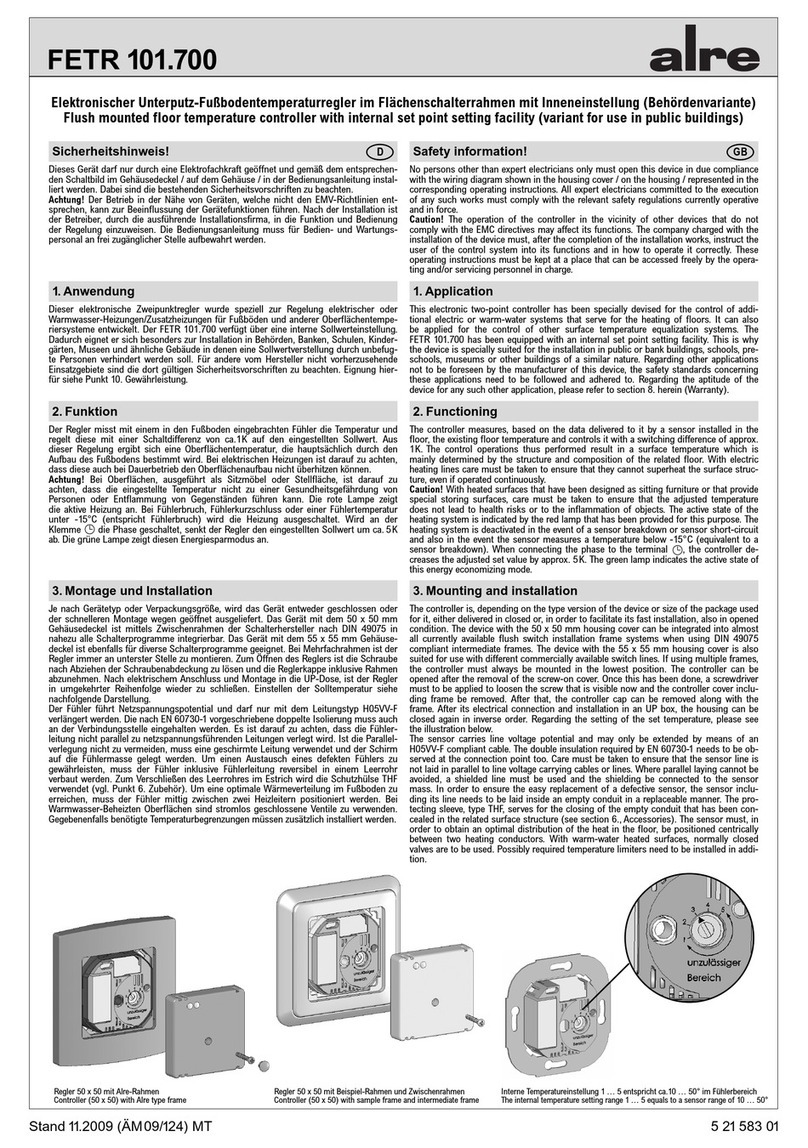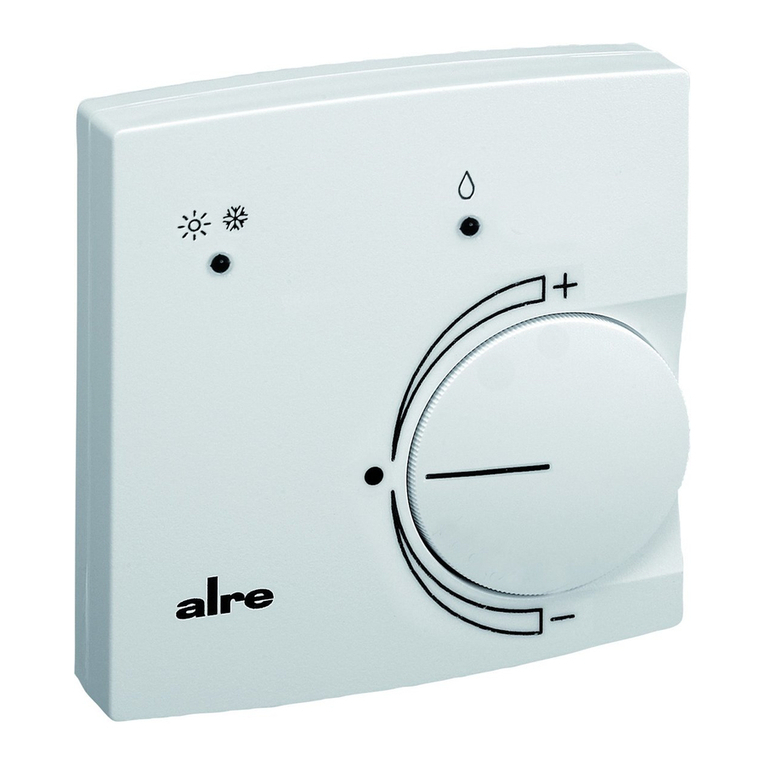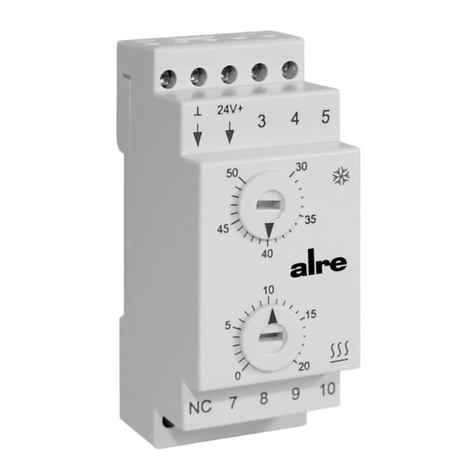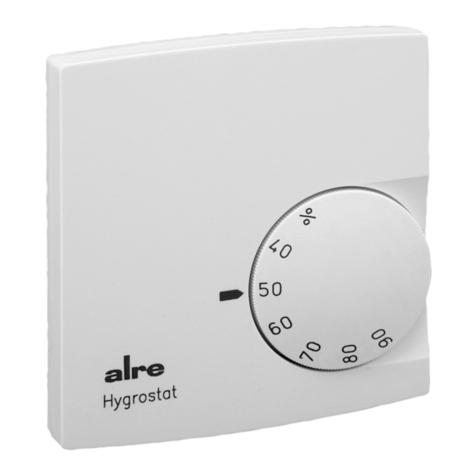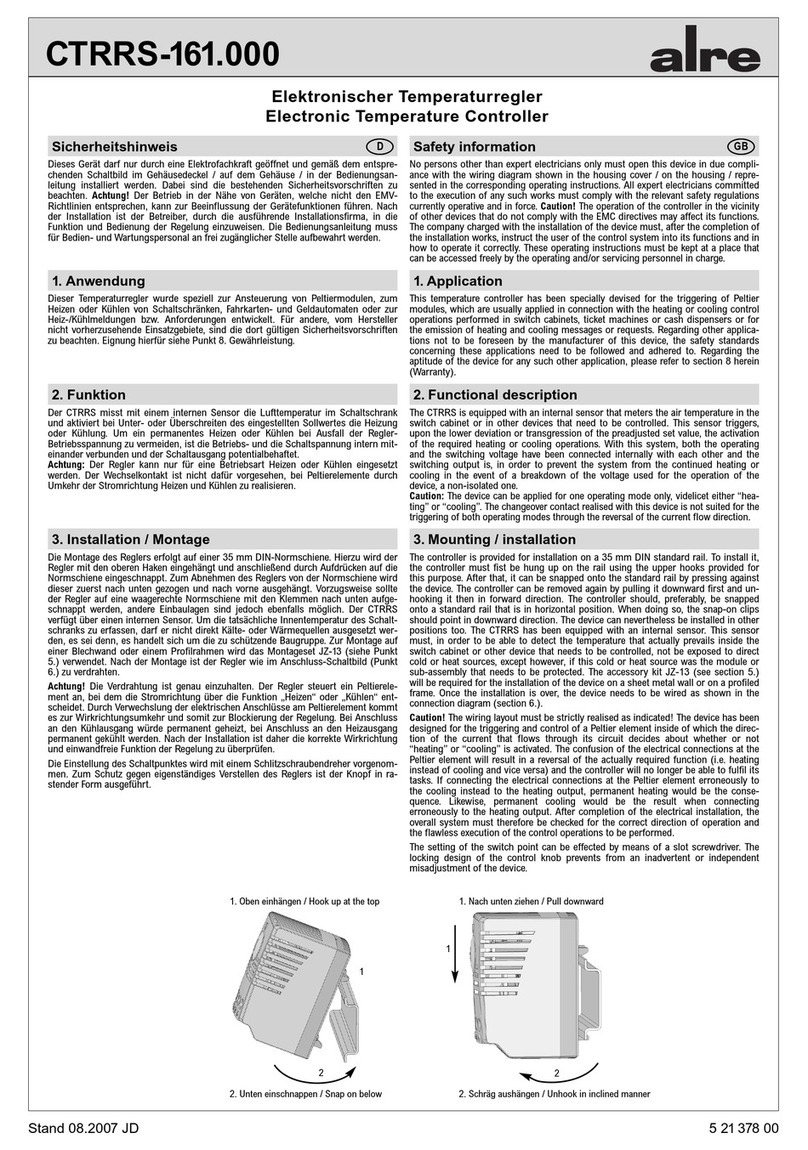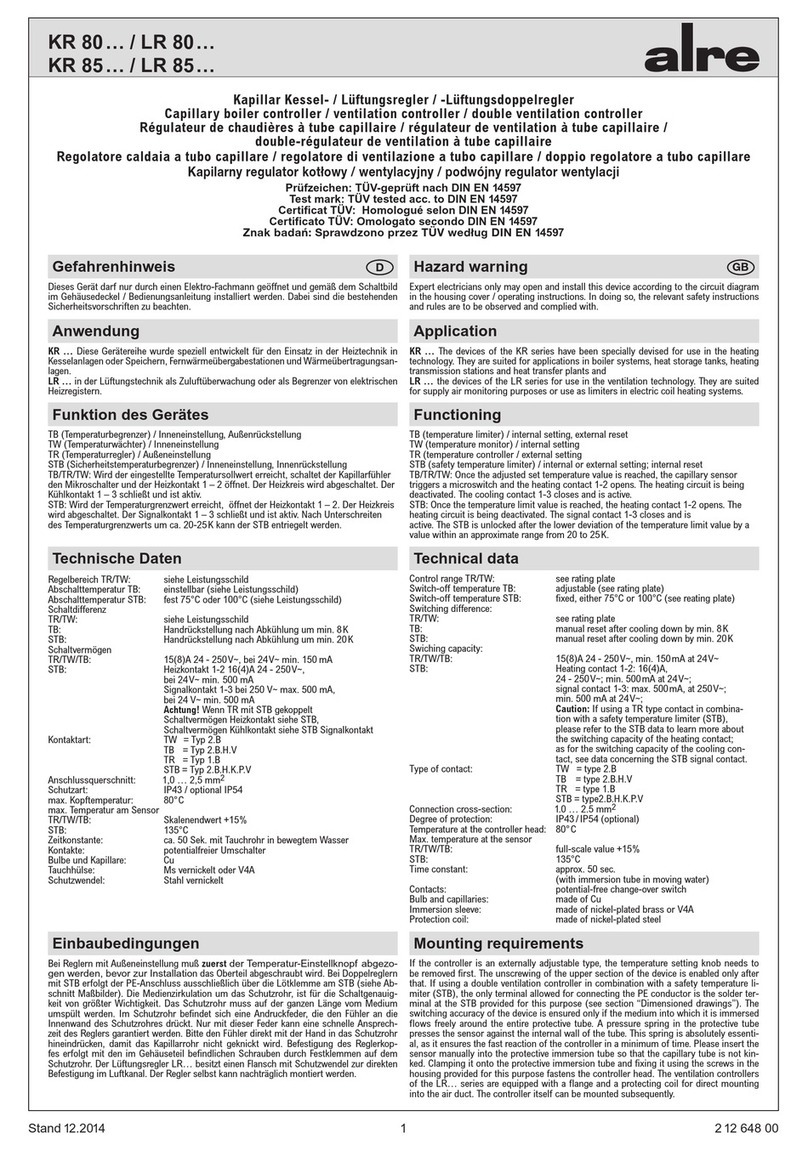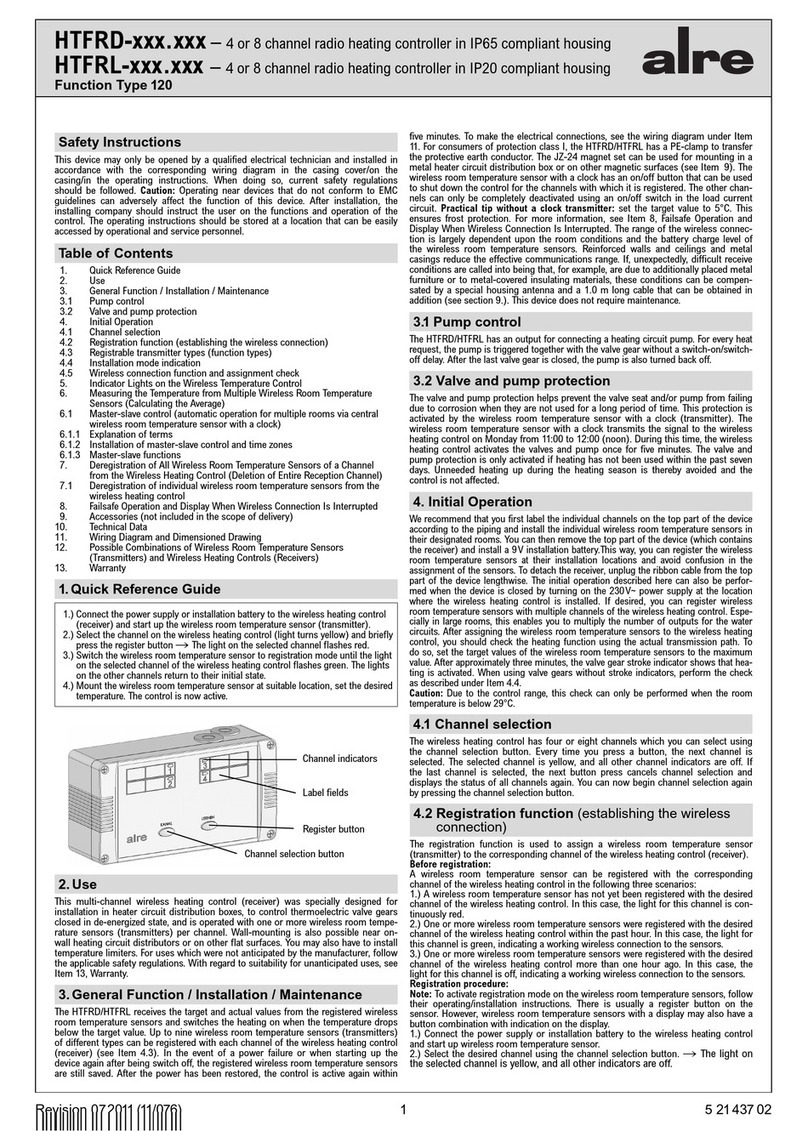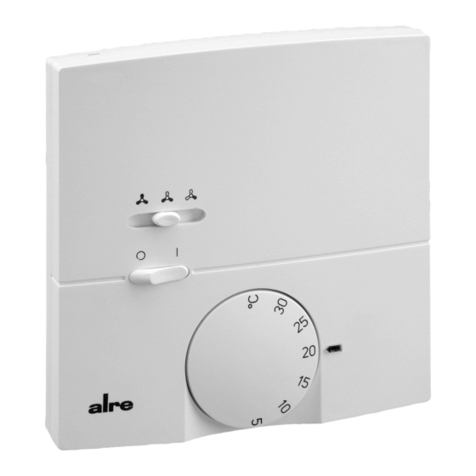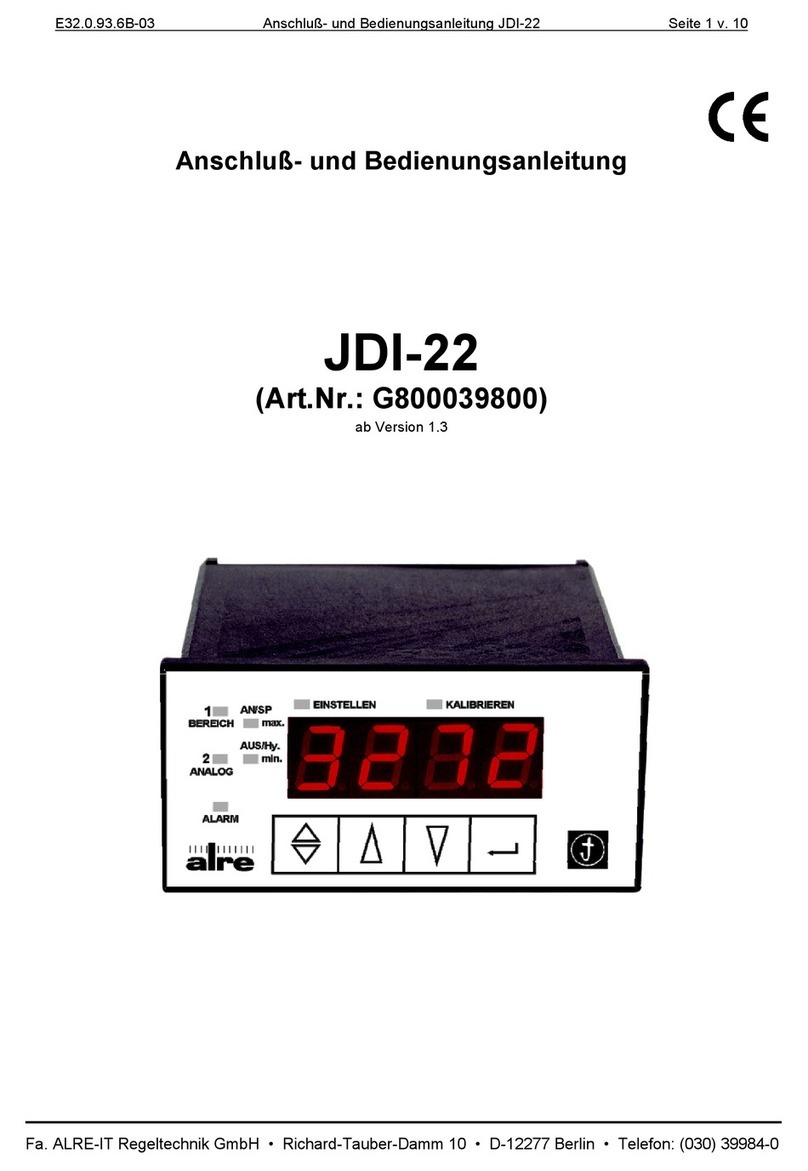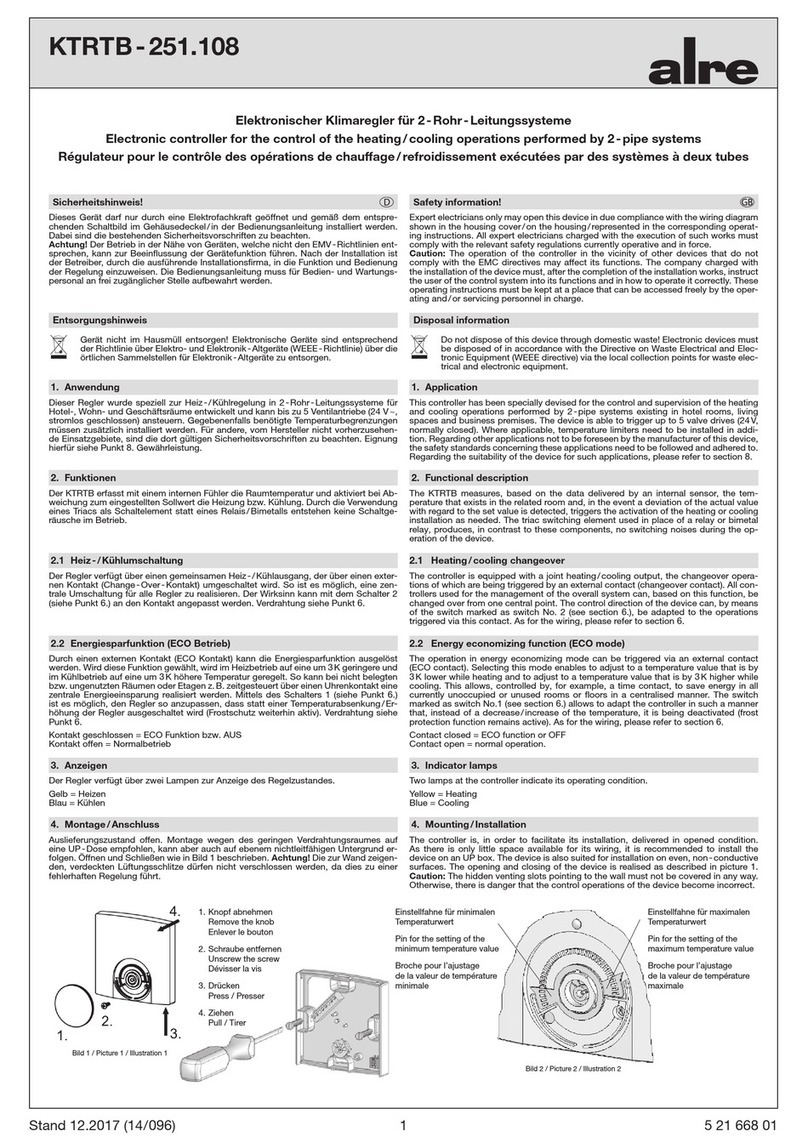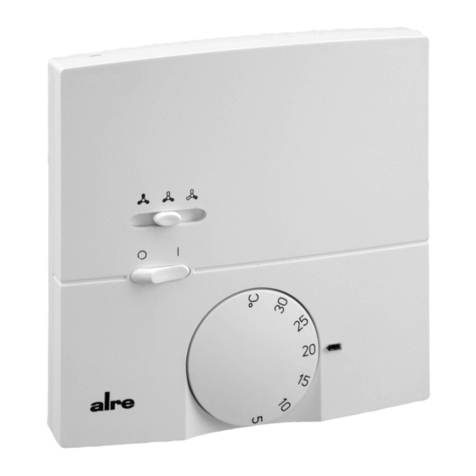KTRRU-052.204 –
KTRRU-052.203 –
Stand 10.2010 (10/112) 1 5 21 252 04
Elektronischer Unterputz-Klimaregler im Flächenschalterrahmen mit
Taupunktaufschaltung zur Regelung von Kühldecken
Flush-framed electronic climate controller with dew point signal addition
for the control of cooling ceilings
Régulateur électronique conçu pour l’installation encastrée avec des cadres de
recouvrement plats, type avec adjonction d’un signal de point de rosée pour la régulation
des opérations climatiques exécutées par des plafonds réfrigérants
Sicherheitshinweis! Safety information!
No persons other than expert electricians only must open this device in due compliance
with the wiring diagram shown in the housing cover / on the housing / represented in the
corresponding operating instructions. All expert electricians committed to the execution
of any such works must comply with the relevant safety regulations currently operative
and in force.
Caution! The operation of the controller in the vicinity of other devices that do not
comply with the EMC directives may affect its functions. The company charged with the
installation of the device must, after the completion of the installation works, instruct the
user of the control system into its functions and in how to operate it correctly. These
operating instructions must be kept at a place that can be accessed freely by the opera-
ting and/or servicing personnel in charge.
DGB
Dieses Gerät darf nur durch eine Elektrofachkraft geöffnet und gemäß dem entsprechen-
den Schaltbild im Gehäusedeckel / auf dem Gehäuse / in der Bedienungsanleitung instal-
liert werden. Dabei sind die bestehenden Sicherheitsvorschriften zu beachten.
Achtung! Der Betrieb in der Nähe von Geräten, welche nicht den EMV-Richtlinien ent-
sprechen, kann zur Beeinflussung der Gerätefunktionen führen. Nach der Installation ist
der Betreiber in die Funktion und Bedienung der Regelung einzuweisen. Die Bedienungs-
anleitung muss für Bedien- und Wartungspersonal an frei zugänglicher Stelle aufbewahrt
werden.
1. Anwendung 1. Application
This controller has been specially devised for the dew point signal addition based control
of the heating and cooling operations performed in 2 and 4-pipe systems that
exist in
hotel rooms, living spaces and business premises. The device is able to trigger
up to 5
valve drives per output (24V, normally closed). The KTRRU is, owing to its dew point
monitoring function, particularly suited for the control of cooling ceilings. Regarding
other applications not to be foreseen by the manufacturer of this device, the safety stan-
dards concerning these applications need to be followed and adhered to. Regarding the
aptitude of the device for any such other application, please refer to section 11. herein
(Warranty).
Dieser Regler wurde speziell zur Heiz-/Kühlregelung in 2- und 4-Rohr-Leitungssystemen
für Hotel-, Wohn- und Geschäftsräume entwickelt und kann bis zu 5 Ventilantriebe
(24V~, stromlos geschlossen) je Ausgang ansteuern. Besonders geeignet ist der KTRRU
durch die Möglichkeit der Taupunktüberwachung zur Kühldeckenregelung. Für andere,
vom Hersteller nicht vorherzusehende Einsatzgebiete, sind die dort gültigen Sicherheits-
vorschriften zu beachten. Eignung hierfür siehe Punkt11. Gewährleistung.
2. Funktionen allgemein 2. General description of the functions of the device
The KTRRU measures, based on the data that are delivered to it by an internal sensor, the
temperature that exists in the related room and, in the event a deviation of the actual
value with regard to the set value is detected, triggers the activation of the heating or
cooling installation as needed. A jumper (jumper 1, see section 9.) enables to adjust the
controller to the pipe system that is to be controlled, scilicet a 2-pipe or 4-pipe system
(factory setting). A neutral zone between the heating and cooling control ranges of
change-over function-less devices that are employed for the control of 4-pipe systems
enables, so long as the required heating and cooling energy is being provided, the
heating and cooling of different rooms within the same building.
2.1. Heating / cooling change-over function for the control of 4-pipe systems
Setting a jumper (jumper 2, see section 9.) enables to select this function. In the case
the related building can only be supplied with either heating or cooling agent, the side of
the system that is not supplied with one of these media at that time, can be disabled by
means of an external contact (change-over contact). Depending on the position of the
switch, either the cooling output during the heating season or the heating output during
the cooling season remains thus untriggered. This function protects the valve drives on
the disabled side of the system and helps save energy. Contact open = operation in
cooling mode (heating circuit disabled); contact closed = operation in heating mode
(cooling circuit disabled).
2.2. Heating / cooling changeover function for the control of 2-pipe systems
A joint heating/cooling output, the changeover of which is triggered by means of an
external contact (changeover contact), enables to use the device for the control of 2-pipe
systems. All controllers employed for the management of the system can, based on this
function, be changed over from one central point. Contact open = operation in cooling
mode; contact closed = operation in heating mode. As for cabling, see section 10.
2.3. Interruption of the cooling operation in the event of the formation of condensate
based on the operation of a special dew point sensor (optional)
Optionally, an external sensor can be connected in addition that enables to trigger the
interruption of the cooling mode operation in the event it detects the formation of con-
densate. This dew point sensor must be installed at the place within the cooling circuit
where the formation of condensate (dew point) is most likely. If this place of installation
cannot be defined clearly, a total of up to 5 dew point sensors can be connected in parallel
to the controller. Preferably, the required dew point sensors should be installed on the
supply line that leads into the related room and/or should be installed close to the
windows. Regarding thereto, please see also section 6.,“Accessories”.
2.4. Energy economizing function (ECO mode)
The economizing function can be triggerd via an external contact (ECO contact) or via a
switch provided for this purpose. a temperature decrease of 3K is effected while opera-
ting in heating mode and a temperature increase of 3K admitted while operating in coo-
ling mode. With currently unoccupied or unused rooms or floors the saving of energy
can, from a central point, thus either be controlled manually or, based on a time contact,
in a time-controlled manner. As for cabling, see section 10.
Contact closed = ECO function; contact opened = normal operating mode.
2.5. Switch functions
The KTRRU-052.204 has been equipped with an “OFF (forced switch-off) / day / ECO”
switch. Even if this switch is in OFF position, the controller continues directing the
related antifreezing operations.
2.6. Antifreezing function
Even if the switch of the KTRRU-052.204 has been set to OFF (forced switch-off), the
supervision and control of the room temperature will be continued. Once the system
detects that frost is imminent, i.e. if temperatures fall below 5°C, the valves are opened
forcibly. Even it the switch has been set to OFF, the frost protection monitoring continues
to be active independent of the actually selected functions or jumper positions. The trig-
gering of the antifreezing function results in the opening of the valves, the activation of
which is indicated by the red indicating lamp.
Der KTRRU misst mit einem internen Fühler die Raumtemperatur und aktiviert bei Ab-
weichung zum eingestellten Sollwert die Heizung bzw. Kühlung. Der Regler wird mittels
Steckbrücke (Jumper 1, vgl. Pkt. 9) an das Leitungssystem, 2-Rohr oder 4-Rohr (Werks-
einstellung) angepasst. Im 4-Rohr-Leitungssystem ohne Change-Over-Funktion wird der
Regler im Heiz-/Kühlbetrieb mit neutraler Zone betrieben, so dass bei gleichzeitiger Be-
reitstellung von Heiz- und Kühlenergie innerhalb eines Gebäudes verschiedene Räume
beheizt und gekühlt werden können.
2.1. Heiz-/Kühlumschaltung im 4-Rohrsystem (Change-Over-Funktion)
Diese Funktion muss mittels Steckbrücke (Jumper 2, vgl. Pkt. 9) ausgewählt werden.
Wenn das Gebäude nicht gleichzeitig mit Heiz- und Kühlmedium versorgt wird, kann
über einen externen Kontakt (Change-Over-Kontakt) die nicht mit Heiz- oder Kühl-
medium versorgte Seite gesperrt werden. So wird je nach Kontaktstellung der Kühlaus-
gang in der Heizsaison oder der Heizausgang in der Kühlsaison nicht angesteuert. Durch
diese Funktion werden die Ventilantriebe der gesperrten Seite geschont und Energie ein-
gespart. Kontakt geöffnet = Kühlbetrieb (Heizkreis gesperrt), Kontakt geschlossen =
Heizbetrieb (Kühlkreis gesperrt).
2.2. Heiz-/Kühlumschaltung im 2-Rohrsystem (Change-Over-Funktion)
Im 2-Rohrbetrieb wird der Regler mit einem gemeinsamen Heiz-/Kühlausgang
betrieben,
der über einen externen Kontakt (Change-Over-Kontakt) umgeschaltet
wird. So ist es
möglich, eine zentrale Umschaltung für alle Regler zu realisieren. Kontakt geöffnet =
Kühlbetrieb, Kontakt geschlossen = Heizbetrieb. Verdrahtung siehe Punkt 10.
2.3. Kühlunterbrechung bei Kondensatbildung durch optionalen Taupunkt-
sensor
Die Funktion kühlen kann bei Kondensatbildung durch einen optionalen externen Sensor
unterbrochen werden. Der Taupunktsensor muss an den Ort mit der größten
Taupunktwahrscheinlichkeit an den Kühlkreislauf montiert werden. Kann dieser
Montageort nicht eindeutig festgelegt werden, besteht die Möglichkeit, bis zu 5
Taupunktsensoren parallel an den Regler anzuschließen. Vorzugsweise sollten die Tau-
punktsensoren am in den Raum führenden Zulauf und/oder im Fensterbereich montiert
werden. Siehe auch Punkt 6. Zubehör.
2.4. Energiesparfunktion (ECO Betrieb)
Durch einen externen Kontakt (ECO Kontakt) oder den Schalter kann die Energie
sparfunk-
tion ausgelöst werden. Wird diese Funktion gewählt, wird im Heizbetrieb auf eine um 3K
geringere und im Kühlbetrieb auf eine um 3K höhere Temperatur geregelt. So kann bei
nicht belegten bzw. ungenutzten Räumen oder Etagen per Hand oder zeitgesteuert über
einen Uhrenkontakt eine zentrale Energieeinsparung realisiert werden. Verdrahtung siehe
Punkt 10.
Kontakt geschlossen = ECO Funktion, Kontakt offen = Normalbetrieb
2.5. Schalterfunktionen
Der KTRRU-052.204 verfügt über einen „Aus(ZwangZu)/Tag/ECO“-Schalter. In Stellung
„Aus“ wird der Frostschutz durch den Regler gewährleistet.
2.6. Frostschutzfunktion
Steht der Schalter des KTRRU-052.204 in Stellung „Aus“ (ZwangZu), wird weiterhin die
Raumtemperatur überwacht und bei Frostgefahr kleiner 5°C die Ventile zwangsgeöffnet.
Die Frostschutzüberwachung ist unabhängig von den gewählten Funktionen und Stellun-
gen der Steckbrücken in Schalterstellung „Aus“ aktiv. Bei Auslösung werden die Ventile
geöffnet und die Aktivierung durch rotes Leuchten der Lampe angezeigt.
ohne Schalter / without this switch / sans commutateur de ce type
mit Aus(ZwangZu)/Tag/ECO-Schalter / with “OFF (forced switch-off)/day/ECO switch”
avec commutateur du type «Arrêt (coupure forcée) / Jour / ECO»
